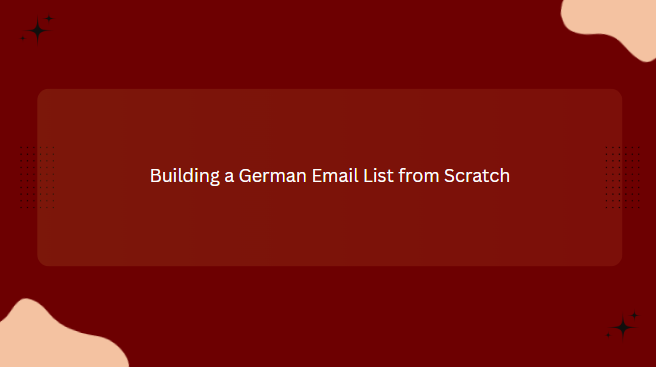Legal Compliance and GDPR Considerations
Germany is part of the European Union, meaning that the General Data Protection Regulation (GDPR) applies in full force to any email marketing efforts. This is not just a formality—it fundamentally shapes how you collect, store, and use email addresses. When building a German email list, you cannot simply scrape or buy addresses from questionable sources. GDPR country wise email marketing list requires explicit, informed consent from the user, usually through a double opt-in process. This means the subscriber first submits their email address and then confirms their subscription by clicking a link in a confirmation email. This two-step process ensures that the person truly wants to receive your messages and protects you from legal risks. Additionally, you must clearly explain how the subscriber’s data will be used, who will have access to it, and how they can opt out at any time. Every email you send should include an easy-to-find unsubscribe link and your full business contact details, as required by German law. Non-compliance can lead to substantial fines—sometimes reaching millions of euros—and long-term damage to your brand’s reputation. Treating data privacy as a core part of your strategy not only keeps you legal but also builds trust with a German audience that highly values security and personal information protection.

Creating an Irresistible Value Proposition for Subscribers
Simply having a sign-up form on your website will not automatically attract people to join your mailing list, especially in Germany where users are cautious about sharing their data. To overcome this, you need to develop a clear and compelling reason for people to subscribe. This is your value proposition, and it should answer the question: “What’s in it for me?” For a German audience, value often means high-quality, relevant, and practical content—think exclusive industry reports, localized guides, insider tips, or early access to special offers. For example, if you run an e-commerce store selling eco-friendly kitchen products, offering a free downloadable guide on sustainable cooking in German could appeal to environmentally conscious consumers. The key is to make the incentive specific, tangible, and relevant to your niche. Avoid generic “Sign up for our newsletter” pitches; instead, focus on what the subscriber will gain. Your sign-up forms should be strategically placed across your digital presence—on your homepage, blog posts, and even in checkout flows—while keeping the process short and user-friendly. Remember that in Germany, offering discounts as an incentive can work, but free high-value content often builds a more loyal and engaged subscriber base over time.
Effective Strategies for Collecting Emails in Germany
Collecting emails in Germany requires both creativity and respect for cultural norms. Content marketing is one of the most effective approaches—blog articles, webinars, or free tools can attract targeted visitors who are more likely to convert into subscribers. Social media platforms like LinkedIn and Xing (a German professional networking site) can also be used to promote sign-ups, especially for B2B audiences. Hosting or participating in local events—whether physical trade fairs or virtual industry conferences—provides another opportunity to collect emails from genuinely interested prospects. Partnering with complementary German businesses for co-branded campaigns can extend your reach while maintaining credibility. Referral incentives can also be effective; encouraging current subscribers to invite friends in exchange for exclusive content or rewards can spread your reach organically. However, each method must comply with GDPR consent rules. Avoid pre-checked boxes or hidden agreements, as these are not considered valid consent in Germany. Additionally, always test different messaging, form placements, and incentives to see which combination drives the highest quality sign-ups without compromising legal or ethical standards. By diversifying your acquisition channels while maintaining compliance, you build a robust and authentic email list that grows steadily over time.
Maintaining and Nurturing Your German Email List
Building your German email list is only the first step; maintaining it is equally important for long-term success. A bloated list filled with inactive or uninterested subscribers can hurt deliverability rates and waste marketing resources. Regularly clean your list by removing or re-engaging inactive subscribers through win-back campaigns. Segmenting your list based on subscriber behavior, purchase history, or expressed interests will allow you to send highly targeted content, improving open and click-through rates. In Germany, thoughtful personalization—such as using the subscriber’s name and addressing them formally when appropriate—can go a long way in creating trust. Be consistent with your email schedule, but avoid overwhelming your audience; a predictable and moderate sending frequency is preferred. Always provide genuine value in every email, whether it’s industry insights, useful tips, or relevant offers. Monitoring performance metrics such as open rates, bounce rates, and unsubscribe rates will help you refine your strategy over time. Ultimately, the goal is to build a relationship with your subscribers, where your emails are welcomed rather than ignored. By combining compliance, cultural awareness, and ongoing value delivery, you can transform your German email list from a static database into a thriving, revenue-generating asset.